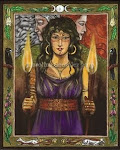
Lammas, also known as Lughnasadh, is the first of the three harvest festivals of the year. It is the time of great bounty when people would start preparing their stock for the coming winter. Being a festival to honor grain and the harvest, it was traditional to bake bread on Lammas. People would only harvest their grain on the day of Lammas and not a day before. This was because if the crops were left in the fields for too long, or the bread not baked in time, the people could starve.
On Lammas, we honor many different Goddesses , such as Ker the grain Goddess, Madron the mother Goddess, and Demeter Goddess of the harvest. Ker was prayed to while ancient women would bake bread on the day of Lammas. Since she is a grain Goddess, they would ask for her to bless their grain so that it would last through the coming months of winter. Madron is the bountiful mother Goddess who gives birth to all the crops. It is said that Madron was worshiped by Neolithic peoples in the British Isles. They would honor her by building sacred mounds on the earth, these were said to represent the womb of the pregnant mother Goddess.
To celebrate Lammas, honor the harvest and mother Goddesses. Pray for their bounty in your own life. On your altar have either a red, orange or yellow candle, or a combination of all three to represent the colors of fall. If possible, have some grain or corn to represent the harvest. A green crystal would represent the fertility of the earth. You could also bake some bread or make a corn dollie. I found pretty simple instructions for making a corn dollie here : SnowOwl
Enjoy your great festival of the Harvest!
Blessings )O(
For more info on Lammas, check out : About.com
Photo courtesy of: Wellfedneighbor.com






